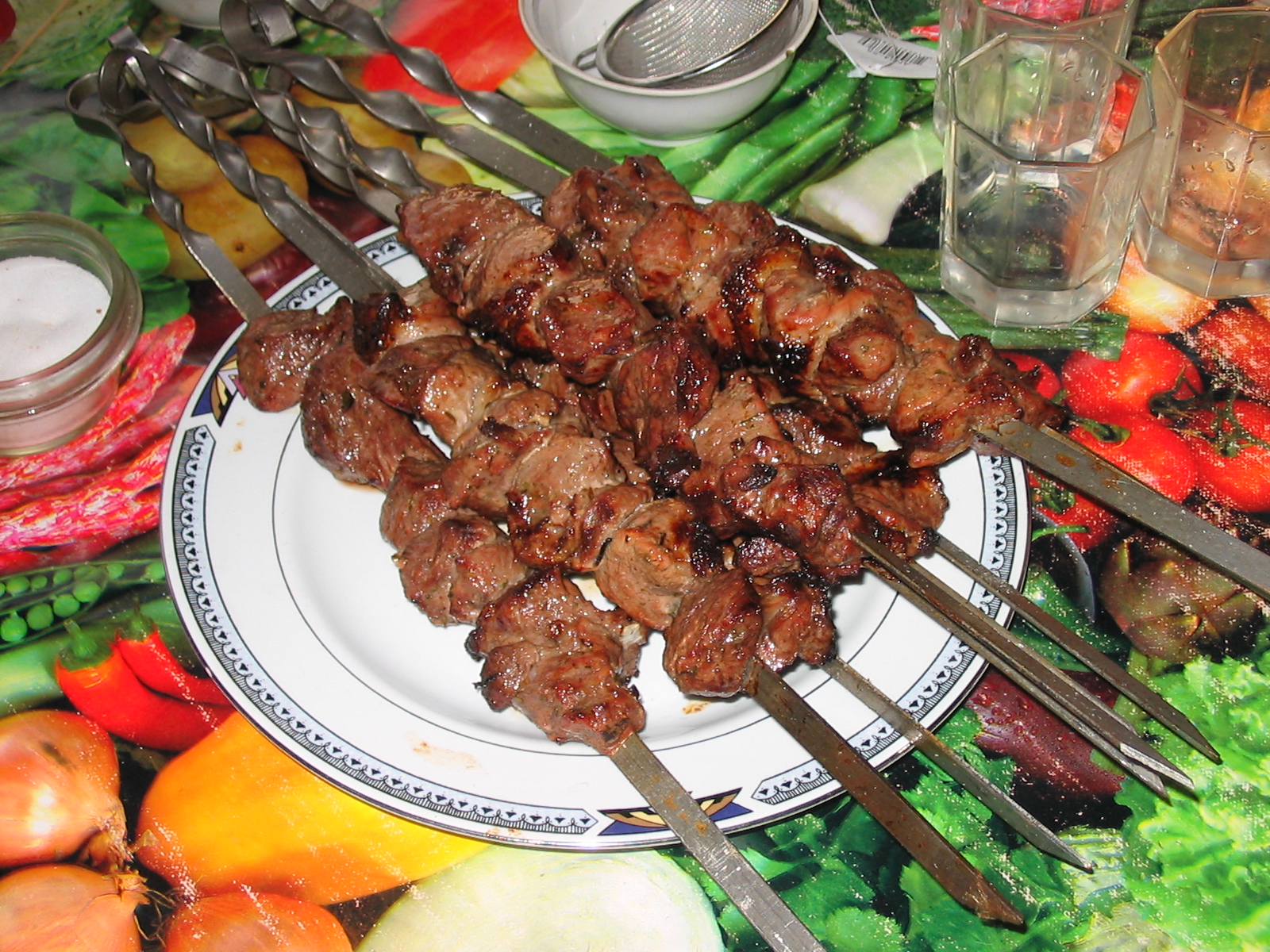Russian cuisine is a collection of the different cooking traditions of the Russian people. The cuisine is diverse, as Russia is by area the largest country in the world.[1] Russian cuisine derives its varied character from the vast and multi-cultural expanse of Russia. Moreover, it is necessary to divide Russian traditional cuisine and Soviet cuisine, which has its own peculiarity. Its foundations were laid by the peasant food of the rural population in an often harsh climate, with a combination of plentiful fish, poultry, game, mushrooms, berries, and honey. Crops of rye, wheat, barley and millet provided the ingredients for a plethora of breads, pancakes, cereals, beer and vodka. Soups and stews full of flavor are centered on seasonal or a usable product, fish and meats. This wholly native food remained the staple for the vast majority of Russians well into the 20th century.
Russia's great expansions of culture, influence, and interest during the 16th–18th centuries brought more refined foods and culinary techniques, as well as one of the most refined food countries in the world. It was during this period that smoked meats and fish, pastry cooking, salads and green vegetables, chocolate, ice cream, wines, and juice were imported from abroad. At least for the urban aristocracy and provincial gentry, this opened the doors for the creative integration of these new foodstuffs with traditional Russian dishes. The result is extremely varied in technique, seasoning, and combination.
Meat
In traditional Russian cuisine three basic variations of meat dishes can be highlighted:
- a large boiled piece of meat cooked in a soup or porridge, and then used as second course or served cold (particularly in jellied stock—see Kholodets' below)
- offal dishes (liver, tripe, etc.), baked in pots together with cereals;
- whole fowl dishes or parts of fowl (legs or breasts), or a large piece of meat (rump) baked on a baking tray in an oven, so-called "zharkoye" (from the word "zhar"(жар) meaning "heat")
The 16th century "Domostroi" aimed at affluent households also mentions sausage-making, spit-roasted meats, stews and many other meat dishes.
As a garnish to meat dishes in the past the most common were porridges and cereals, in which the meat was boiled, later on boiled or rather steamed and baked root vegetables (turnips, carrots) as well as mushrooms; additionally the meat, without taking account its type, was garnished with pickled products—pickled cabbage, sour and "soaked" (marinated) apples (mochoniye yabloki), soaked cranberries, "vzvar"s. Pan juices, alone or mixed with sour cream or melted butter is used as gravy to pour on garnishing vegetables and porridges. Meat sauces i.e. gravies based on flour, butter, eggs and milk, are not common for traditional Russian cuisine.
 Shashlyk is a form of Shish kebab (marinated meat grilled on a skewer) popular in former Soviet Union countries, notably in Georgia, Russia, Armenia, Azerbaijan, and Uzbekistan. It often features alternating slices of meat and onions. Even though the word "shashlyk" was apparently borrowed from the Crimean Tatars by the Cossacks as early as the 16th century, kebabs did not reach Moscow until the late 19th century, according to Vladimir Gilyarovsky's "Moscow and Moscovites". From then on, their popularity spread rapidly; by the 1910s they were a staple in St Petersburg restaurants and by the 1920s they were already a pervasive street food all over urban Russia. Shashlik is also used in Russia as a food to be cooked in outdoor environment, similarly to barbecue in English-speaking countries.
Shashlyk is a form of Shish kebab (marinated meat grilled on a skewer) popular in former Soviet Union countries, notably in Georgia, Russia, Armenia, Azerbaijan, and Uzbekistan. It often features alternating slices of meat and onions. Even though the word "shashlyk" was apparently borrowed from the Crimean Tatars by the Cossacks as early as the 16th century, kebabs did not reach Moscow until the late 19th century, according to Vladimir Gilyarovsky's "Moscow and Moscovites". From then on, their popularity spread rapidly; by the 1910s they were a staple in St Petersburg restaurants and by the 1920s they were already a pervasive street food all over urban Russia. Shashlik is also used in Russia as a food to be cooked in outdoor environment, similarly to barbecue in English-speaking countries.Hot soups
Rassolnik is a hot soup in a salty-sour cucumber base. This dish formed in Russian cuisine quite late—only in the 19th century. About this time the name rassolnik was attached to it, originating from the Russian word rassol which means "brine (food)" (pickle water). Pickle water was known to be used as base for soups from the 15th century at the latest. Its concentration and ratio with other liquids and soup components gave birth to different soups: solyanka, shchi, and of course rassolnik. The latest are moderately sour-salty soups on pickled cucumber base. Some are vegetarian, but more often with products like veal or beef kidneys or all poultry giblets (stomach, liver, heart, neck, feet). For best taste there has to be a balance between the sour part and neutral absorbers (cereals, potatoes, root vegetables). Typical rassolnik is based on kidneys, brine (and pickles), vegetables and barley.
Shchi (cabbage soup) had been the predominant first course in Russian cuisine for over a thousand years. Although tastes have changed, it steadily made its way through several epochs. Shchi knew no social class boundaries, and even if the rich had richer ingredients and the poor made it solely of cabbage and onions, all these "poor" and "rich" variations were cooked in the same tradition. The unique taste of this cabbage soup was from the fact that after cooking it was left to draw (stew) in a Russian stove. The "Spirit of shchi" was inseparable from a Russian izba (log hut). Many Russian proverbs are connected to this soup, such as Shchi da kasha pishcha nasha (Russian: Щи да каша — пища наша, "Shchi and porridge are our staples"). It can be eaten regularly, and at any time of the year.
The richer variant of shchi includes several ingredients, but the first and last components are a must:
- Cabbage.
- Meat (very rarely fish or mushrooms).
- Carrots, basil or parsley roots.
- Spicy herbs (onions, celery, dill, garlic, pepper, bay leaf).
- Sour components (smetana, apples, sauerkraut, pickle water).
Alcoholic Beverage

Of Russia's alcoholic beverages, perhaps the most ancient is Medovukha, a sweet, low-alcohol drink, made with fermented-honey with the addition of various spices. A stronger honey-based beverage, stavlenniy myod, also exists in Russia and is broadly equivalent to Scandinavian mead; it is typically made with the admixture of berry juices.
Vodka is the most well-known of Russia's alcoholic products and is produced, with some variation, throughout the country. Vodka can be either grain or potato based and is frequently flavored with a great variety of ingredients ranging from hot-pepper and horseradish to fruits and berries.
Beer has been manufactured in Russia since at the very least the 9th century. Its popularity was for many centuries concentrated in the Lands of Novgorod. Beer continued to be made throughout Russian history, but real growth came in the 18th century when many breweries were founded in order to supply the newly modernized and expanded imperial army and fleet. A real explosion in the popularity of beer came in the last decades of the Soviet Era and has continued into the present day, with Russia now ranking as the fourth largest producer in the world.
Wine is manufactured in the southern regions in the country, but lags far behind other alcoholic beverages in popularity. The wine industry, which was somewhat notable in imperial times, is slowly expanding, but most Russians that drink wine tend to prefer imported foreign varieties, especially sweet varieties produced in the countries of the former USSR and little known in the outside world.
Non-alcoholic Beverage
Kvass is an ancient and still widely popular bread-based drink. The basic method of preparing kvass includes water, flour and liquid malt; these ingredients are used to make a dough that is subjected to fermentation. This results in a beverage with very low alcohol content. Commercial kvas is often around 0.5% alcohol. The fermented liquid, referred to as "zator," is diluted with water and mixed with yeast, sugar, and aromatic additives. This final mixture is allowed to brew for several days. Flavor additives may include fruit and berry juices (cherry, raspberry, lemon, etc.), as well as ginger and mint.
Sbiten, another non-alcoholic drink, is made of honey, water, fruit juices, and spices. Sbiten was once the most popular non-alcoholic beverage in the country, but in the last few centuries it has been superseded and largely replaced by tea and coffee.


No comments:
Post a Comment